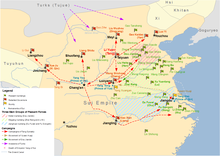
Back دوران انتقالی از سوئی به تانگ Persian Transition des Sui aux Tang French Transisi dari Sui ke Tang ID 隋末唐初 Japanese 수말당초 Korean Смена империи Суй империей Тан Russian Tùy mạt Đường sơ Vietnamese 唐朝开国战争 Chinese
This article needs additional citations for verification. (March 2018) |
| Transition from Sui to Tang | ||||||||
|---|---|---|---|---|---|---|---|---|
 Major uprisings in the eve of the fall of the Sui dynasty | ||||||||
| ||||||||
| Belligerents | ||||||||
| Tang dynasty |
Sui dynasty (until 618) Qin Liang Deng Yang Zheng Xia Han Dong Liang | Eastern Turkic Khaganate | ||||||
| Casualties and losses | ||||||||
| At least 1 million deaths | ||||||||
| Transition from Sui to Tang | |||||||
|---|---|---|---|---|---|---|---|
| Traditional Chinese | 唐朝開國戰爭 | ||||||
| Simplified Chinese | 唐朝开国战争 | ||||||
| Literal meaning | Tang dynasty founding war | ||||||
| |||||||
The transition from Sui to Tang (613–628), or simply the Sui-Tang transition,[1] was the period of Chinese history between the end of the Sui dynasty and the start of the Tang dynasty. The Sui dynasty's territories were carved into a handful of short-lived states by its officials, generals, and agrarian rebel leaders. A process of elimination and annexation followed that ultimately culminated in the consolidation of the Tang dynasty by the former Sui general Li Yuan. Near the end of the Sui, Li Yuan installed the puppet child emperor Yang You. Li later executed Yang and proclaimed himself emperor of the new Tang dynasty.
The transition started roughly around the year of 613 when Emperor Yang of Sui launched his first of three campaigns against Goguryeo, leading to a number of desertions in the army and the start of agrarian revolt against the Sui. The transition ended in 628, when Emperor Gaozu's son Li Shimin annexed the agrarian rebel ruler Liang Shidu's state of Liang, thereby once again unifying most of China under a single power.
- ^ Martin W. Huang (2006). Negotiating masculinities in late imperial China. University of Hawai'i Press. p. 126. ISBN 9780824828967.